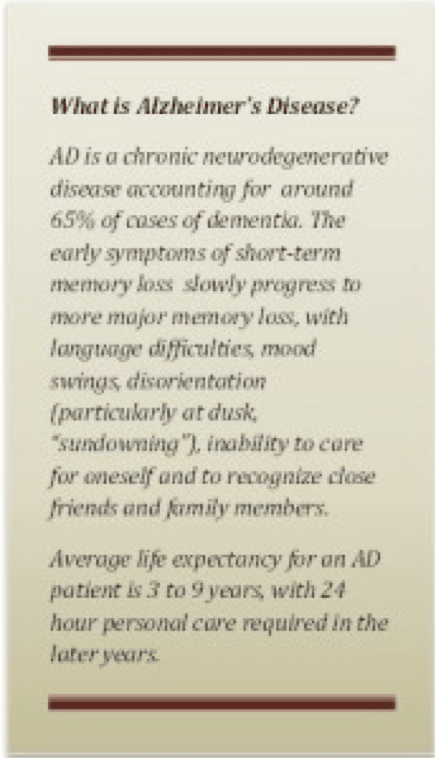
The Grim Facts About Alzheimer’s Disease
It’s been called a coming “tsunami” with good reason. One in eight elder Americans have Alzheimer’s Disease (AD) and one in three elder Americans die with AD or another dementia. As baby boomers enter their golden years, the AD population is expected to nearly treble from 5.3 million in 2015 to 13.8 million by 2050, at an estimated cost of 1.1 trillion dollars and one in three of every Medicare dollar. Other developed nations face similar crises.
The National Alzheimer’s Project Act (NAPA)
Many national and state governments have recognized the tsunami threat and have put forward plans to address it. In 2011 President Obama signed the National Alzheimer’s Project Act (NAPA) with its number one goal to “Prevent and Effectively Treat Alzheimer’s Disease by 2025.” But behind the bold proposals actual government funding has been lack-luster. However, last month Congress passed a spending bill increasing Alzheimer’s research funding, effectively doubling the current $586 million to $1 Billion per year.
Presidential hopeful Hilary Clinton has proposed doubling funding again, calling for “rapidly” ramping up NIH spending on Alzheimer’s disease to $2 billion per year. While other leading presidential candidates have offered no such specific plans, they have been supportive: Bernie Sanders says he “believes very strongly” in more AD funding. Donald Trump, said that AD was a “total top priority for me”. In subcommittee hearings, Ted Cruz has strongly advocated more money be spent on AD Research. Marco Rubio said that a “Manhattan Project-style focus” is required on AD research.
With these greater gusts behind its sails can science now reach the NAPA goal and head off the tsunami?
The Science Underlying Alzheimer’s Disease
To date there exists no effective cure for AD, nor any effective prevention. Worse still, there is scant understanding of the disease, its causes are unknown, as is its method of action on the brain. But there are clues for medical scientists to follow: from autopsies, for instance, it’s known that the brains of AD patients have distinctive plaques of the protein amyloid beta (Aβ), and also tangles of the protein tau.
Competing hypotheses for the cause of AD include: Mutations in various genes; reduced synthesis of the neurotransmitter acetylcholine; extracellular amyloid beta (Aβ) deposits; tau protein abnormalities; poor functioning of the blood brain barrier.
Here’s a glimpse at two of the most recent promising discoveries by AD researchers:
Environmental Toxin Contributing to Alzheimer’s Disease?
Back in the 1950s many native peoples of the island of Guam, the Chamorros, were dying of a paralytic disease with dementia symptoms. In post-mortems, US Army doctors noticed abnormal collections of proteins in the brains of sufferers similar to those of AD patients.
Fast-forward to the late 1990s when researchers led by Dr Paul Cox picked up the trail, visited Guam and found high levels of Beta-N-methylamino-L-alanine (BMAA) in water pools and the seeds of the local cycad palm trees. BMAA is an environmental toxin made by certain bacteria. The Chamorros use these seeds to make flour for tortillas and also cook fruit bats which eat the Cycad seeds and also showed high levels of BMAA.
And now Dr Cox and colleagues at the University of Miami’s Institute of Ethnomedicine have reported the results of an experiment on BMAA. Monkeys fed fruit laced with BMAA developed similar abnormal proteins (tangles) in the brain, proving the causal effect of BMAA. Further studies show BMAA mimics an amino acid called L-serine and inserts itself into brain proteins, causing them to misfold and tangle.
Currently clinical trials are testing whether giving patients L-serine tablets might prevent the misfolding effect.
The work was published in the January 2016 issue of the journal Proceedings of the Royal Society B.
Brain Inflammation in Alzheimer’s Disease
AD Researchers at the Centre for Biological Science at the University of Southampton in England have recently found that “inflammation in the brain can in fact drive the development of the disease.” And that blocking a receptor in the brain that regulates immune cells could “protect against the memory and behavior changes seen in the progression of Alzheimer’s disease.”
The researchers, lead by Diego Gomez-Nicola, first compared brain tissue samples from AD patients with those from healthy people of the same age. The Alzheimer’s samples were found to contain more of immune cells called microglia than healthy ones.
The research team then conducted a study on mice bred to develop the characteristics of Alzheimer’s. The mice were given a drug which blocks CSF1R, a receptor that regulates microglia. The treated mice were able to demonstrate “fewer memory and behavioral problems.” than the untreated mice.
The work was published in the January 2016 issue of the journal Brain.
The Future of Treatment and Prevention of Alzheimer’s Disease
Whether either of these two particular recent discoveries eventually lead to a method to prevent or treat AD is unknown. But with more and more funded AD research under sail there is reasonable hope that the effects of Alzheimer’s Tsunami can be at least reduced and a cure found within our lifetimes.
Snowfish integrates, clinical, analytic, and business insights for life sciences companies. We have long experience of working on issues of older adults, and particularly on AD and other dementias. We have built comprehensive databases and reports for clients on every aspect of the AD landscape, based on our own research and a wide variety of resources. Snowfish attends the major AD meetings including NAPA Advisory and NIH Alzheimer’s Summit meetings.
Please reach out to Snowfish so we can help you map out your own landscape. Call us at (703) 759-6100 or check us out at snowfish.net.
- Market Access: The Latest Hurdle for Treating Alzheimer’s and Dementia - June 14, 2023
- Rare Disease Outreach a Missed Opportunity - November 7, 2022
- So You Read Our Previous Post on Biomarkers? - August 1, 2022




